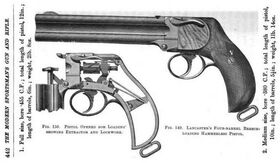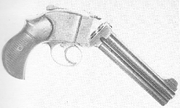The Lancaster was a multi-barreled pistol designed by British gunsmith Henry A. A. Thorn and produced primarily by the gunsmithing business of Charles Lancaster, from which it ultimately took its name. In its day, the Lancaster was a popular alternative to the revolver in the British market.
The Lancaster is often categorized as a "Howdah pistol", a generic term referring to large-caliber, multi-barreled pistols that were commonly used by hunters and explorers in parts of the world that were considered dangerous, such as Sub-Saharan Africa and rural India.
History[]
The Lancaster pistol was developed at the firm of the late Charles Lancaster, a London gunsmith who died in 1847. His son, Charles William Lancaster, inherited the business and took on Henry Thorn as an apprentice. Thorn developed the oval bore system while working at the Lancaster firm in 1870 and later designed the Lancaster pistol as a gun to implement his new system.
In 1879, Charles William died and Thorn bought the business, although continued to trade under its reputable name for marketing purposes. He began producing his pistol in large numbers, as it had received some demand from British officers stationed in Britain's colonies, specifically those in India and Africa, who thought revolvers inadequate due to their comparatively lower stopping power.
The Lancaster pistol was at the height of its popularity in the 1880s and there was consideration for its adoption by the Royal Field Artillery, but it was ultimately never issued to British soldiers on an official basis.
By the beginning of the 20th century, the popularity of Howdah guns such as the Lancaster pistol had diminished, largely due to the introduction of self-loading pistols such as the Mauser C96. There are unsubstantiated claims that some British officers continued to carry Lancasters during World War I, although Webley revolvers were a much more popular choice.
A Lancaster pistol was notably used by Colonel Fred Burnably during the Battle of Abu Klea in 1885.
Design Details[]

A detailed drawing of the Lancaster Pistol firing mechanism.
The Lancaster worked on the basis of simplicity, over the more complicated mechanisms of the revolvers of the time. The lack of complicated firing mechanism, protected by a relatively bulky (but by no means unncessarily) frame casing, meant that the Lancaster could cope with almost any condition without the risk of jamming or suffer particularly from wear and tear.
The Lancaster was manufactured with either two or four barrels. Interestingly the Lancaster was not given a conventional form of rifling. Instead the bore of the barrel was made with a slight ovaloid (rather than conventional round) shape. This shape imparted a slight twist to the bullet, which was a simpler solution to the issue of rifling without the problem of fouling when the pistol was shot (a result of the blackpowder used at the time which had a habit of blocking the grooves of the rifling, effectively making the rifling redundent and, after prolonged use, cause the gun to jam).
The Lancaster featured a break-barrel design, supported by a hinge underneath the barrels at the point at which they joined the frame. This allowed the Lancaster to be reloaded much like a revolver and, because of the lack of a cylinder rotating behind the barrel, a virtually air tight seal could be formed at the end of the barrel, making the Lancaster safer to use (in British Officers eyes) then the revolvers of the time (which would produce gas from the sides of the cylinder, potentially burning the user). The barrels were then locked into position via a latch on the top of the frame.
The Lancaster features an unusual firing mechanism, featuring a grooved cylinder (located inside the frame) upon which the firing pin/striker would follow to strike the cartridge loaded into each barrel. This mechanism was held within the frame of the Lancaster and was accessable through the removal of the grips. The grooved cylinder would later appear on the Webley-Fosbery Automatic Revolver, a novel attempt at an automatic revolver.
Ammunition[]
The Lancaster fired the most common calibre sizes of the era, the .380", .450 Adams and .455 Webley. Due to the fact that the Lancaster had a virtually air-tight seal, the muzzle velocity and stopping power produced by each of these rounds much greater than they would have otherwise achieved in the revolvers they were designed for.
Related weapons[]

The rifle version.
Lancaster rifle - Henry Thorn developed a full-size, large-bore rifle variant based on the same principles as the pistol. The rifle had four barrels. It was commercially unsuccessful due to its unwieldy build.

An example of the Bland pistol.

The Bland pistol opened.
Bland pistol - This improved copy of the Lancaster pistol was produced by Thomas Bland & Sons of London in the mid-1880s. Few were made and other than their markings, they are hard to distinguish from regular Lancaster pistols. Bland pistols were offered with four barrels and were chambered in .476 calibre.
Martin-Marres-Braendlin Mitrailleuse - A pistol of a similar design produced from 1880 to 1888, which acted as a commercial rival to the Lancaster.
References[]
http://en.wikipedia.org/wiki/Lancaster_pistol
http://www.victorianwars.com/viewtopic.php?f=21&t=911
The Illustrated Encyclopedia of Firearms - Ian V. Hogg